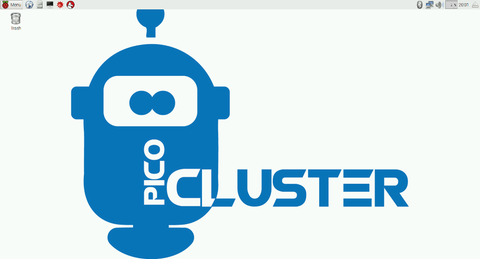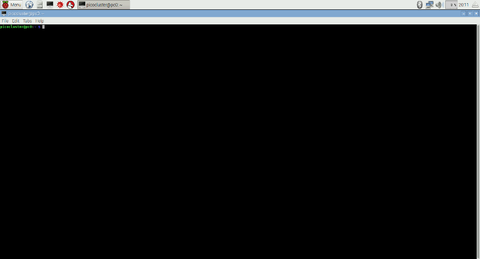You've got your PicoCluster up and running, so what's next?
You can either plug in a mouse, keyboard, and monitor to use PicoCluster as a desktop computer cluster, or connect to PicoCluster over the network.
Logging on:
If you choose the desktop route, the first screen you see after booting is the login screen. The default username is picocluster with password picocluster. Should make sense, right?
If you choose to connect over the network, then the default IP address if pc0 is 10.1.10.240. The default username is picocluster with password picocluster.
This is the default node layout for a Pico 5
10.1.10.240 pc0 10.1.10.241 pc1 10.1.10.242 pc2 10.1.10.243 pc3 10.1.10.244 pc4
PicoCluster Desktop:

This is what you see when you log into the PicoCluster desktop.
Now we need to pull up the Linux Shell so we can see what else is pre-configured with the PicoCluster Image Set.

In the upper left hand corner, you'll seen the terminal icon. If you click that, then you'll open up the terminal application. Click on the enlarge window icon in the upper right hand corner of the terminal window, and you'll get this:

We have the Linux Terminal application up and running. Now we can look around.
If you logged on over the network, then you're already here.
Looking around:
picocluster@pc0:~ $ ls Desktop Downloads Music Pictures Public stopAllNodes.sh testAllNodes.sh Documents genKeys.sh PicoCluster_Background.png Pimoroni restartAllNodes.sh Templates Videos
We see 4 shells scripts here to make this a little easier for us.
restartAllNodes.sh is used to restart all of the nodes in the cluster.
stopAllNodes.sh is used to stop or shut down all of the nodes in the cluster. You would normally run this script before disconnecting power to PicoCluster. Simply pulling power from PicoCluster runs a high risk of corrupting the micro SD cards on one or more of the nodes.
genKeys.sh is used to generate and SSH key and distribute it to all nodes.
testAllNodes.sh does a simple df -h on each node to indicate that each node is up and running.
picocluster@pc0:~ $ sh testAllNodes.sh testing pc4 Filesystem Size Used Avail Use% Mounted on /dev/root 15G 3.3G 11G 24% / devtmpfs 459M 0 459M 0% /dev tmpfs 463M 0 463M 0% /dev/shm tmpfs 463M 6.3M 457M 2% /run tmpfs 5.0M 4.0K 5.0M 1% /run/lock tmpfs 463M 0 463M 0% /sys/fs/cgroup /dev/mmcblk0p1 63M 21M 43M 33% /boot tmpfs 93M 0 93M 0% /run/user/1000 tmpfs 93M 0 93M 0% /run/user/109 tmpfs 93M 0 93M 0% /run/user/1001 testing pc3 Filesystem Size Used Avail Use% Mounted on /dev/root 15G 3.3G 11G 24% / devtmpfs 459M 0 459M 0% /dev tmpfs 463M 0 463M 0% /dev/shm tmpfs 463M 6.3M 457M 2% /run tmpfs 5.0M 4.0K 5.0M 1% /run/lock tmpfs 463M 0 463M 0% /sys/fs/cgroup /dev/mmcblk0p1 63M 21M 43M 33% /boot tmpfs 93M 0 93M 0% /run/user/1000 tmpfs 93M 0 93M 0% /run/user/109 tmpfs 93M 0 93M 0% /run/user/1001 testing pc2 Filesystem Size Used Avail Use% Mounted on /dev/root 15G 3.3G 11G 24% / devtmpfs 459M 0 459M 0% /dev tmpfs 463M 0 463M 0% /dev/shm tmpfs 463M 6.3M 457M 2% /run tmpfs 5.0M 4.0K 5.0M 1% /run/lock tmpfs 463M 0 463M 0% /sys/fs/cgroup /dev/mmcblk0p1 63M 21M 43M 33% /boot tmpfs 93M 0 93M 0% /run/user/1000 tmpfs 93M 0 93M 0% /run/user/109 tmpfs 93M 0 93M 0% /run/user/1001 testing pc1 Filesystem Size Used Avail Use% Mounted on /dev/root 15G 3.3G 11G 24% / devtmpfs 459M 0 459M 0% /dev tmpfs 463M 0 463M 0% /dev/shm tmpfs 463M 6.3M 457M 2% /run tmpfs 5.0M 4.0K 5.0M 1% /run/lock tmpfs 463M 0 463M 0% /sys/fs/cgroup /dev/mmcblk0p1 63M 21M 43M 33% /boot tmpfs 93M 0 93M 0% /run/user/1000 tmpfs 93M 0 93M 0% /run/user/109 tmpfs 93M 0 93M 0% /run/user/1001 testing pc0 Filesystem Size Used Avail Use% Mounted on /dev/root 15G 3.4G 11G 24% / devtmpfs 459M 0 459M 0% /dev tmpfs 463M 0 463M 0% /dev/shm tmpfs 463M 6.4M 457M 2% /run tmpfs 5.0M 4.0K 5.0M 1% /run/lock tmpfs 463M 0 463M 0% /sys/fs/cgroup /dev/mmcblk0p1 63M 21M 43M 33% /boot tmpfs 93M 0 93M 0% /run/user/1000 tmpfs 93M 0 93M 0% /run/user/109 tmpfs 93M 0 93M 0% /run/user/1001
Pimoroni Blink! LEDs
If you noticed in the directory listing above, there is a Pimorni directory. This is the library install for the Pimoroni Blinkt! LED Python library with examples. If you purchase and LED set, then the libraries are all ready for you. This is for Raspberry PI only.
Now you're up and running:
This should be enough to get you up and running. PicoCluster is an amazing tool, with limitless possibilities, so feel free to explore it to it's fullest!
Contact us at support@picocluster.com for questions.
